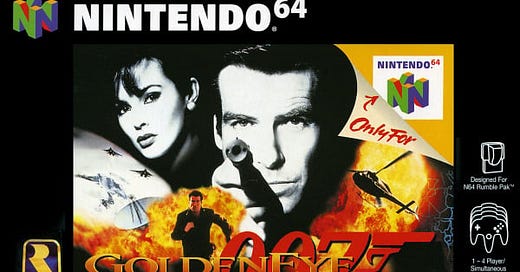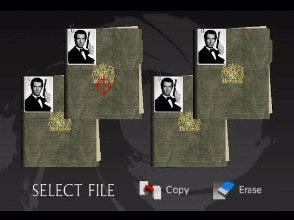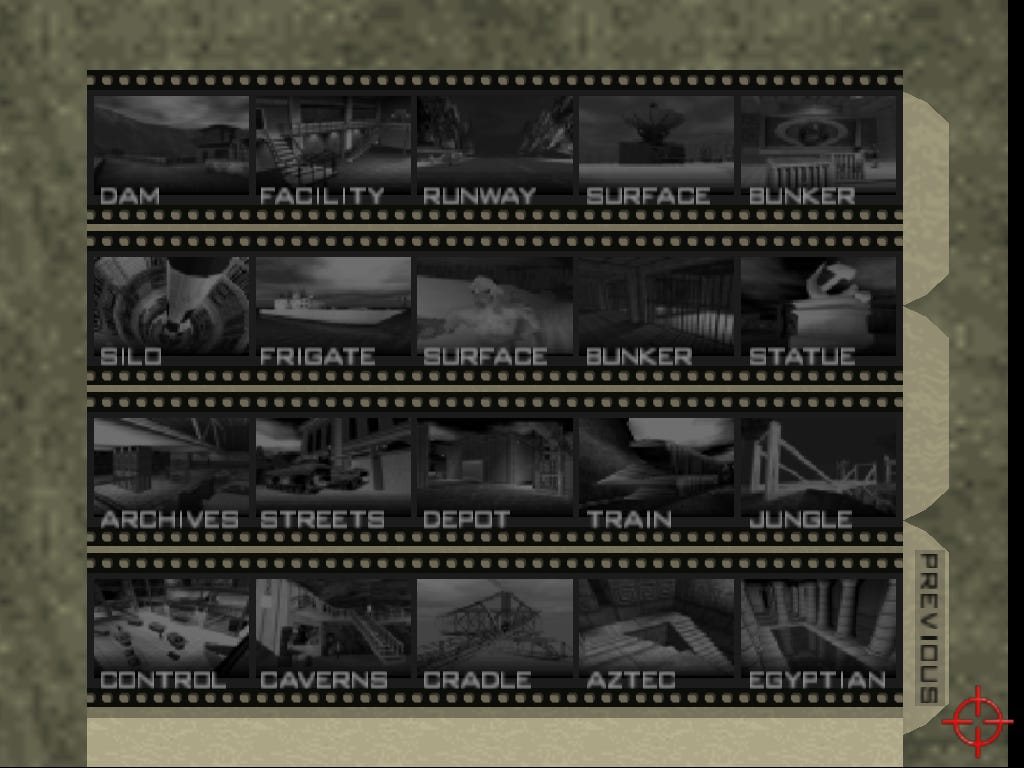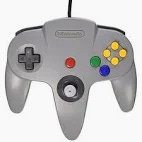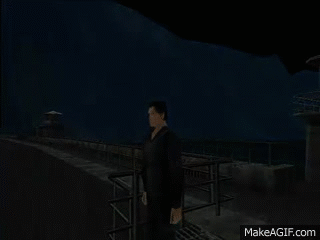27 Years Later, is Goldeneye 007 Still Worth Playing?
Critiquing and exploring the history of a Nintendo 64 titan
INTRODUCTION
About a year and a half after the eponymous film’s release and punch drunk from a series of delays and near-cancellations, Rare’s Goldeneye 007 arrived on shelves, more shaken than stirred and to the fanfare of few people. For the overwhelming majority of film tie-in games, the story would have ended there but as so often happens in the gaming industry, the people spoke up and the word of Goldeneye was spread until the seminal shooter grew into a gaming cultural phenomenon.
Goldeneye 007 Box Art (Rare, 1997, Nintendo)
But I’m not writing to sing Goldeneye’s praises blindly or to espouse the same dogmatic opinions you’ve likely heard before; everyone knows the seismic impact of Goldeneye 007 on its genre and on the Nintendo 64’s library but is it still worth playing now? A few weeks ago, I sat myself in-front of my preferred CRT, Nintendo 64 controller in-hand to answer this question for myself.
Before we dive into the meat of this article, this is my first piece on Substack, therefore I’ll begin with a slither of background about myself; think of it as the lens through which I’ll be viewing this piece of history.
I was born in the year 2000 when the Nintendo 64 was due to be replaced and didn’t get my hands on one until long after the console had left shop shelves and although I did grow up with this fascinating little console, I unfortunately missed out on Goldeneye, however, I have a deep love and sense of nostalgia for the Timesplitters series which was worked on by some of the key figures behind this game, so I hope you’ll trust my pedigree in this very specific breed of shooter and understand that I’m not approaching it from the perspective of someone who is unfamiliar with the genre and looking to ‘expose’ a beloved game but instead as a player looking to make more great memories with the predecessor of a cherished favourite.
With that being said I’ll begin the review by inviting you to grab a hot drink and to get comfortable.
Goldeneye 007’s Menu is spartan yet incredibly immersive
MUSIC AND SOUND
Goldeneye opens, as all good James Bond should, with a gun-barrel sequence and it’s at this point you’ll begin to hear just how excellent the game’s soundtrack is. The game roars with a rock rendition of the iconic James Bond theme and a film-style cast list depicting the characters the player will encounter during the campaign. Jam-packed inside Goldeneye’s 12MB cartridge are 53 of gaming’s most iconic pieces of music composed by Graeme Norgate, Grant Kirkhope and Robin Beanland. For each of these composers the Goldeneye 007 soundtrack was among their first projects in the gaming industry, so to open with this soundtrack front and centre speaks volumes to the confidence in their work these composers and Rare must have had; it even contains the recognisable, industrial ‘pipe’ sound used in the film. That confidence in sound and in presentation is converted into anticipation in the player.
If I had to pick a favourite piece of music from the game it would be either the industrial-middle eastern mix for the mission ‘Egyptian’, or the synthy, intense Frigate mission’s soundtrack.
An issue I have with the majority of modern shooters is that weapons all sound realistic (and therefore all very similar) so they feel interchangeable in the player’s hands; how many versions of the Kalashnikov can I unlock in Battlefield before they feel even remotely distinct? In Goldeneye, however, each and every firearm has its own unique sound. In a First Person Shooter, the gun the player wields serves not only as a gameplay tool but also as the on-screen avatar so it’s fitting that each and every one be given its own personality.
Unfortunately, if you press the ‘Start’ button you will be carried to the Select File screen and suffer some painful tonal whiplash as the pleasant but much less energetic menu theme begins; fragmented and disconnected design will be a running theme in this critique.
PRESENTATION, GRAPHICS AND CONTROLS
A more positive aspect of this Select File menu and the connected Mission Select screen is that it immediately immerses the player into the role of James Bond, part of this is that the Save Files are actual paper folders, emblazoned with ‘FOR YOUR EYES ONLY’ when you open one to play your selected save game, as well as that, the Erase option being an actual chunk of rubber really reinforces the fact that this menu has a place in the game’s world and narrative, the player is an employee at MI6 opening Bond’s file and once the save file is open, the briefings make it clear that the player is filling the role of Bond himself preparing for a mission.
This is masterful presentation.
Goldeneye’s Mission Select is oddly drab
One aspect of these menus’ presentation that I found lacking, however was in the Mission Select screen. The menu has an in-character microfilm aesthetic and this works well but instead of the briefings including a slide-show or these images being in colour, they are tinted with a muddy black and white colour scheme and only one image represents the selected mission.
Although usually black and white, colour microfilm did exist, especially by the game’s mid-90’s setting and given the maze-like nature of some of the game’s missions, a short slide show for the player to browse while reading mission briefings would have been very helpful but levels are short enough and the Nintendo 64 cartridges had severe memory limitations so given the other strengths in these menus’ presentation, I can certainly forgive this minor nit-pick.
When I selected the first mission of the game: Dam and began to play I was struck immediately by 2 things: the strength of the game’s controls despite working with a challenging piece of hardware and the aging of its graphical presentation in comparison with its peers.
The Nintendo 64 controller is oversized and unergonomic, yet perfectly designed for early First Person Shooters like Goldeneye 007
When Goldeneye was brought to modern platforms in 2023, many players found its dated control scheme difficult to grasp, however I have nothing but praise for the controls in this game; they are not to a modern standard of course and I find the Nintendo 64 controller hopelessly uncomfortable but there is a fluidity to controlling Goldeneye that its predecessors like Turok: Dinosaur Hunter don’t possess.
The most often recommended control scheme: solitaire has the player control Bond’s movement with the yellow C-Pad, looking around with the control stick and firing the game’s many weapons with the Z button; the player can also bring up Bond’s watch with Start, which pauses the game and accesses various options. The A and B buttons reload and swap between weapons with either bumper button activating a more precise aiming mode that brings up a bright red reticule on the screen which the player can control like a mouse cursor. This mode also unlocks a crouched stance and the ability to lean around cover.
I was thoroughly impressed to find such a robust array of options for the player in a game of Goldeneye’s age and the pause menu in Goldeneye is probably the best ever made too, modelled after Bond’s famous Omega Seamaster 300M watch and tuned with another unique Bond theme rendition, it has become famous for the level of cool it oozes.
The majority of modern First Person Shooters don’t contain a lean option for the player and the heavy-handed aim assist present in a series like Call of Duty is far inferior to the balanced system found in Goldeneye where the precision aiming mode contains no aim assist, allowing the expression of a player’s skill, while in the default mode of aiming, the aim assist will only gravitate to the enemy’s torso, where it takes many shots to kill.
But what does this all mean in practice? In its moment to moment gameplay, the player will find Goldeneye easy to learn but hard to master, beginning with a reliance on the aim assist and spitting bullets from a deep ammunition pool but gradually, as the missions go by, transforming into an adept 00 Agent able to pull off headshots consistently and to predict the guards’ rotoscoped rolls and dives with growing ease.
On the other hand, I find the graphical fidelity of Goldeneye to not measure up against some of 1997’s other titles. Doom 64 and the aforementioned Turok: Dinosaur Hunter both released in the same year as Goldeneye and provide a much more gratifying visual feast by comparison, with the former having some stunning skyboxes and 2D sprites and the latter being filled with richly detailed 3D models and vast jungles.
I suspect the graphics of Goldeneye were kept to a happy medium in order to avoid using excessive draw distance fog (a problem Turok suffered with) or to keep performance respectable… but this proved to be a fruitless endeavour. Those who have played Goldeneye on its native Nintendo 64 have likely been waiting for this aspect of the game’s presentation to be discussed and here it is: the biggest issue with Goldeneye’s presentation, graphical or otherwise and perhaps my biggest complaint with the game as a whole is that it runs at a sickeningly low framerate.
When I say a sickeningly low framerate, I’m not exaggerating. This is not a 30FPS versus 60FPS situation, Goldeneye runs consistently around the 15FPS mark but drops to 10FPS or below in most combat encounters involving more than 3 enemies. Not only does this framerate turn many combat encounters into a slide-show but it can induce motion sickness in individuals sensitive to it.
If you get easily motion sick or are sensitive to lower framerates then right away I can say that playing Goldeneye on original hardware won’t be worth your while and that you should instead look into trying the game on modern systems.
GAMEPLAY, BALANCE AND LEVEL DESIGN
The objective of Goldeneye is to make your way through the campaign’s 18 missions (and 2 unlockable secret ones) roughly based on the plot of the film by completing sets of objectives that scale up and down with the selected difficulty; Rare were actually permitted access to the film’s sets, so many of the game’s missions bear a striking resemblance to it.
Goldeneye 007 even recreates the iconic bungee jump off the Arkangel Chemical Weapons Facility Dam
The level design of Goldeneye was unorthodox for its time, favouring naturalistic environments with many non-essential rooms as opposed to the zeitgeist of linear stages and an approach to game design that favoured trimming the fat; this innovative design was a by-product of Goldeneye being the first project for almost its entire development team.
This lends itself to greater immersion but rarely to a good experience for the first time player.
It took a while for Goldeneye’s levels to ‘click’ for me, as I suspect it will for many players. Without a map, your first few attempts at each mission will likely see you stumbling around aimlessly, armed with nothing but your starting weapon and a vague outline of your objectives until you’re lucky enough to stumble upon what you’re looking for or die trying. But this is where the true genius of Goldeneye’s level and mission design kicks in because this is the most replayable First Person Shooter campaign ever made. The player’s accuracy, time taken to complete the mission, selected difficulty, preferred weapon, all are tracked on the scoresheet at the end of the level with high speed awarding unlockable cheats and high accuracy awarding bragging rights.
As irritating as learning the layout of some of the lengthier, more difficult missions can be I quickly found myself forgiving this minor shortcoming because it serves an addictive replayability which has allowed Goldeneye’s speed running scene to continue to thrive even now: almost 30 years since the game’s release.
Like every game though, there are some unenjoyable missions in Goldeneye and at its worse, this campaign feels designed for strategy guides or in extreme cases, borderline unplayable. My first major frustration came when I reached the mission Bunker II which sees Bond escaping from prison with Natalya, erasing evidence of his presence there and gathering intelligence on the Janus Crime Syndicate along the way. As it turns out, the stealth mechanics of Goldeneye have some real depth to them, the first shot from any unsilenced weapon is always inaudible to guards as are your bare hands and the throwing knives are silent too but if you fire unsilenced weapons repeatedly or use explosives, you will alert all guards in the vicinity; the more noise you make, the wider the area you alert becomes, basically.
This sounds like a reasonable and straight forward system except at no point in the game is it ever explained to you and guards can’t alert other guards by firing their weapons. What followed was me pausing the game after somewhere in the realm of 6-8 attempts at this mission to read up on how the stealth works and to discover that you can fire through the glass windows in this mission. A more experienced team at the helm would have taught the player these mechanics through the level design itself a la Super Mario Bros. this could have been done by allowing escape from the prison cell only by firing through a pane of glass to trigger a switch or by having a guard right outside the door to the prison who is never alerted by his comrade who is scripted to always detect the player once they escape but instead you’re expected to just work it out somehow.
This is all made doubly frustrating by the fact that Goldeneye’s throwing knives: your main weapons in Bunker II are one of the worst weapons I’ve ever used in a First Person Shooter.
A puzzling choice that also rears its ugly head in this level is the decision to make gadgets only equip-able via the equipment menu and not accessible via cycling through your weapons normally. What this means is that every time the player wants to make another attempt at Bunker II, they have to perform the same slow routine of opening the menu, cycling to Bond’s magnetic watch and then attracting the keys to open the door; trivial on paper, tedious in practice.
Later in the game there were far worse offenders than Bunker II as well. The mission Depot has you rummaging through half a dozen identical looking warehouses to locate your objective, the Archives mission where I had to use a walkthrough to work out where one character was in a maze of olive green corridors, for every iconic and beloved mission in Goldeneye like Facility, Frigate or Silo, there are 2 other missions like Surface or Statue that are just plain boring.
My point is that Goldeneye is a game of quantity over quality and out of the 20 missions in this game, I think only 10 or 11 are any good and my complaint about the Throwing Knives earlier extends to half of the game’s arsenal too with the Klobb submachine gun being the butt of many a joke among Goldeneye’s players.
That was a long wall of text, enjoy this picture of Doctor Doak, modelled after Rare employee David Doak
I mentioned earlier that the game can become unplayable under extreme circumstances and that happens when high difficulty meets low framerate, the worst example being the infamous mission: Control.
The climax of this mission has the player defending the fragile Natalya Simonova from a horde of guards as explosions erupt, glass shatters and lift doors open and close spilling out more meat for the grinder. Keeping Natalya alive requires the player research a few common strategies online and even if the player learns to defend her well, the framerate slows to such a horrendous crawl that the entire fight becomes twice as difficult; several times, I was killed on the home stretch by elite guards when the game suddenly dropped to around 5-10FPS and I had to turn off my console and step away in frustration.
Difficulty in the final couple of missions in general is a bit of a bad joke as the game breaks its own rules by introducing a new type of soldier that is miraculously immune to headshots when it has so far has conditioned the player to aim for the head as the quickest route to victory.
From my complaints so far you might have gotten the impression that Goldeneye is a nightmare to play and to be honest, some missions are but 80% of the time the run and gun gameplay, mastering the aiming system and getting to grips with the stealth mechanics make the flow of gameplay extremely compelling and that makes at least 11 of the game’s missions worth playing.
”SO THAT’S THE CONCLUSION? ONLY HALF OF GOLDENEYE IS WORTH PLAYING?”
I have to confess, this wasn’t the first time I’d attempted to play Goldeneye a few years ago I attempted to finish the game and bounced off quite quickly, well then what was different this time?
In all of gaming but particularly with playing retro I think there are games that anyone can enjoy: the Super Marios, Call of Duties, Minecrafts and Animal Crossings of the world but on the other hand we have games for genre enthusiasts or experienced gamers like Hearts of Iron, Dark Souls and pretty much every fighting game ever made; Goldeneye is from the latter group of games.
What was different this time was the mindset I approached with, I learned the game, like a skill, developed a deep enjoyment of its run and gun/stealth mix and found reward in doing better each time.
I mean it with zero elitism and judgement when I say that Goldeneye is not a game for everybody. For those of you out there who like to play a well-balanced game with an interesting narrative, gameplay variety and a smooth difficulty curve, this game won’t be worth playing for you because the mission objective variety and amount of narrative you’re supplied with directly corresponds to the difficulty you choose and the 00 Agent mode (Hard) is seriously tough.
To really get the most out of Goldeneye you need to be the sort of player who can celebrate marginal gains like completing the mission 2 seconds quicker than last time or completing an extra objective before you died, the kind of player who will love Goldeneye is the player who can enjoy the arcade-like loop of accumulating a score/some kind of increasing reward until that golden run when your thumbs work overtime, your reflexes are sharp and you manage to pass to the next mission.
SO IS GOLDENEYE STILL WORTH PLAYING TODAY?
If you’re the type of retro gamer who finds the original hardware and intended experience of a videogame to be inherently worthwhile, even if it sometimes hurts then I would say yes.
If you’re the kind of player who can eat 5 losses in Tekken 8 or die 15 times to the same boss in Dark Souls but find solace in the fact that you shaved off more health points than last time then I would say yes.
But if you’re the kind of player who gets easily tilted from repeated deaths, is prone to rage when you die at the final hurdle or are unaccustomed to Nintendo 64 shooters, I would seek out the Xbox version with its modified controls or search for a certain cancelled remake that may or may not exist for the PC.
Lastly, I know some of you grew up with this game and are looking for the opinion of the next generation on a beloved classic and wondering if going back will spoil your memories, only you can answer that for sure but I will say I thoroughly enjoyed my time with Goldeneye; Rare is perhaps the greatest British video game developer of all time and Goldeneye is the cream of the crop of their legacy. As a Bond fan, I can tell the love for the films that has been poured into every little 1 and 0 contained inside this little cartridge and as a fan of classic First Person Shooters, I’d slap this game in my console anytime.
How do YOU remember Goldeneye? Do you have any special memories to share? Maybe you disagree with my review? Feel free to comment below where I’ll gladly read your thoughts.

